US offensive in the Pacific and Southeast Asia on 1945
By the beginning of 1945, the military strategic position of the Japanese Empire had deteriorated significantly. Launched in Japan by the Japanese 1944, the offensive in China got stuck. The rebuff of the Chinese forces (the armies of the Kuomintang and the people's troops — there was no unified government in China) increased. In Burma, the Japanese troops, having lost their superiority, were forced to retreat. At the Pacific Theater, the Japanese Empire was deprived of its mandates and the central part of the Philippine Islands. The Japanese fleet suffered heavy losses and lost the ability to conduct active operations. Three Japanese armies (17-I, 18-I and 31-I) were blocked on the islands of the Bismarck Archipelago, New Guinea and the Caroline Islands. The fighting from the central and southwestern parts of the Pacific Ocean moved to the South China Sea and to the near approaches to the Japanese islands.
However, the Japanese leadership still had large human reserves and relied on the economy of the metropolis and the resources of the territories of Korea, China, Taiwan, and the territories of Southeast Asia that remained under Japanese rule. Despite the decline in production, Japan could still produce the main types of weapons. For the first seven and a half months of the 1945, the Japanese built 22 submarines, 6 destroyers and more than 11 thousand aircraft. Numerous military enterprises producing artillery weapons and ammunition were operating in Japan and Northeast China. There were stocks of chemical and biological weapons.
Japan had a powerful army, which in the previous battles suffered relatively minor losses, which were easily replenished. By the beginning of 1945, 5 million 365 thousand soldiers were under arms. Ground forces along with his aviation numbered 4,1 million people, naval forces - 1 million 265 thousand people. In the occupied territory of China there were more than 1,8 million soldiers and officers, in the countries of Southeast Asia - about 0,5 million people (including 300 thousand people on the Burmese front), and 338 thousand people on the islands of the Pacific Ocean. and actually in Japan (including the Ryukyu Islands) - more than 1,4 million people. Almost the entire naval personnel were also in the metropolis. fleet. In addition, in January 1945, the "Program of emergency measures necessary to achieve victory" was launched, which provided for the creation of new 44 divisions from conscripts of the third mobilization phase.
Japanese aviation by this time was already significantly weakened and had about 8,8 thousand aircraft. Most of the air force was stationed on the Japanese islands, in Korea and China. Part of the aircraft fleet was represented by special-purpose projectiles such as the Yokosuka MXY7 Ohka. Aircraft "Oka", letters. "Sakura flower" (the Americans called these planes "tank", that is, "fool") were small, simple in design and cheap to manufacture. A wooden airframe with a powerful explosive charge in the bow (1-1,2 tons), a single pilot cabin in the middle part and a rocket engine in the tail section of the hull, had no take-off engines and landing gear, was lifted into the air by a carrier plane. The projectile had a limited radius of action and was intended to destroy enemy surface ships. The suicide pilot died with the car.
To the beginning of the 1945, the Japanese Navy was very weak and had: 6 battleships (2 were aircraft carriers), 4 aircraft carriers with 48 aircraft, 7 cruisers, 22 destroyers and 44 submarines. The main forces of the fleet were based in Japan. A critical shortage of fuel has reduced fleet activity to a minimum. Several cruisers and a small number of light fleet forces were deployed in the area of the Malay Archipelago and the Bay of Bengal.
Thus, controlling vast territories on the mainland, relying on the military-industrial complex of the Japanese islands, Manchuria (Northeast China) and Korea, as well as having large contingents of ground forces and aviation, large human reserves, the Japanese leadership planned to provide long-term and stubborn resistance on land theater.
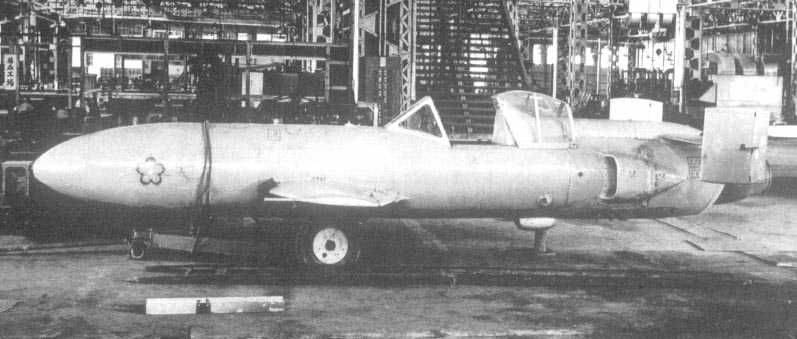
Yokosuka MXY7 Ohka (model 22). On board you can see a stylized image of a sakura flower.
Military plans
The 25 Supreme Military Council of January 1945 adopted a general war management plan, which said: “By continuing decisive efforts in the field of warfare and counting on a favorable turn in military events, the empire will at the same time immediately create an active defense system based on Japan, Manchuria, China and will persevere in a protracted war. ” The authorities planned to carry out the general arming of the people, the militarization of the most important industries and transport, as well as the reorganization of the system of local administration, which was supposed to be ready for the defensive actions of the armed forces.
In accordance with the strategic course for the continuation of the war, a plan of military action was drawn up for 1945. The Kwantung Army, deployed on the USSR’s Far Eastern borders, was planned to be strengthened in case of complications in relations with Moscow. To this end, troops from other regions of China were going to relocate to Northeast China.
At the Chinese theater, the Japanese hoped to smash the Chinese people's troops opposing them and defeat the Kuomintang armies, forcing the government of Chiang Kai-shek to make peace. China was to remain the main pillar of the Japanese Empire on the mainland. In the countries of Southeast Asia, the Japanese command hoped to stay in Burma and thwart the invasion of the US-British troops in Malaya and Indonesia. To enhance the defense in the southern strategic direction at the end of 1944, the forces of the 16 Army were deployed to Sumatra and Malaya, which took up positions on the islands of Celebes, Borneo and Java.
At the Pacific Theater, the Japanese command planned to stop the movement of the US-British forces by defending the approaches to Japan and the coast of China and thus gain time to prepare for the “decisive battle” for the Japanese islands proper. The main tasks of defense, set out in the “Ten” plan in March 1945, were as follows: to maintain positions in the areas of the Ryukyu Islands, Taiwan and Shanghai; in a hopeless situation, inflict as much losses on the enemy as possible and try to thwart them by creating air bases; continue preparing the defense of the islands of the metropolis. The ground forces and the Air Force were to play the main role in repelling enemy strikes, the surface fleet was planned to be used in exceptional cases and with favorable opportunities.
The position and plans of the US-British forces
The United States and the United Kingdom to the beginning of 1945, have achieved great success. The Japanese fleet was basically turned off. The Allies occupied most of the Pacific Islands and fought for the Philippines. Successfully developed offensive in Burma, organized in 1944 year.
By 1945, the American command concentrated on the Pacific Ocean up to 90% of the country's naval forces, four combined-arms and three air armies, strategic air force units, as well as a large number of special units and service troops. On 1 October, 1944, the American forces in the Pacific Ocean numbered more than 1,3 million soldiers and officers. They were supported by 100 th. Australian contingent. It was planned that 2 million 250 thousand people and 7 thousand aircraft would take part in the attack on the Japanese metropolis. The US Pacific Fleet at the start of the 1945 of the year totaled the 23 battleship, the 94 aircraft carrier, the 57 heavy and light cruisers, and the 350 destroyers. 217 submarines and thousands of different landing and auxiliary vessels. At the end of 1944, Britain sent its fleet to the Pacific, which included the 2 battleship, the 4 aircraft carrier, the 3 cruiser, and a number of destroyers and other ships. On the Burmese front, the US-British command had an 500 thousand army with about 2500 aircraft (just over half of the vehicles were British, others were American). In the Indian Ocean was located another British fleet supporting the actions of ground forces in Burma from the side of the Bay of Bengal. The British East Indies fleet consisted of 2 battleships, 5 aircraft carriers, 7 cruisers and other combat and auxiliary ships.
As a result, the US-British armed forces in the Pacific and Southeast Asia had more than double the superiority in aviation, thirteen-fold in aircraft carriers, four- and sevenfold in other classes of warships. In the land forces, the Japanese army still had an advantage. The superiority in the naval and air forces allowed the American-British forces to conduct an offensive in the Pacific Theater and in Burma. But for the deployment of a strategic offensive in Asia and on the Japanese islands, the number of US-British ground forces was considered insufficient. The American command was expecting furious resistance and huge losses in Japan. In this case, even with the loss of the Japanese islands, the Japanese army could offer long-term resistance in the huge Chinese theater.
Therefore, the position of the Soviet Union in the Far East acquired tremendous importance. Preliminary talks on this issue, held before 1945 of the year and confirmed by the Yalta Treaty of February 11 of the 1945 of the year, were taken into account by the Western powers when planning operations for the 1945 year. The main directives to the armed forces developed by the US Committee of the Chiefs of Staff for 1 December 1944 of the year and updated by 22 in January 1945 set the dates for the invasion of Japan, depending on the situation at the European theater of operations. In the first months of 1945, the Americans planned to complete the operation to seize the Philippines, to go to the near approaches to Japan, to create operational bases to ensure a naval blockade and air strikes on the Japanese metropolis. The operation to capture the main Japanese islands of Kyushu and Honshu was planned for the winter of 1945-1946. or on 1946 year. In Southeast Asia, the US-British command planned to liberate Burma and Malaya and unblock the Strait of Malacca.
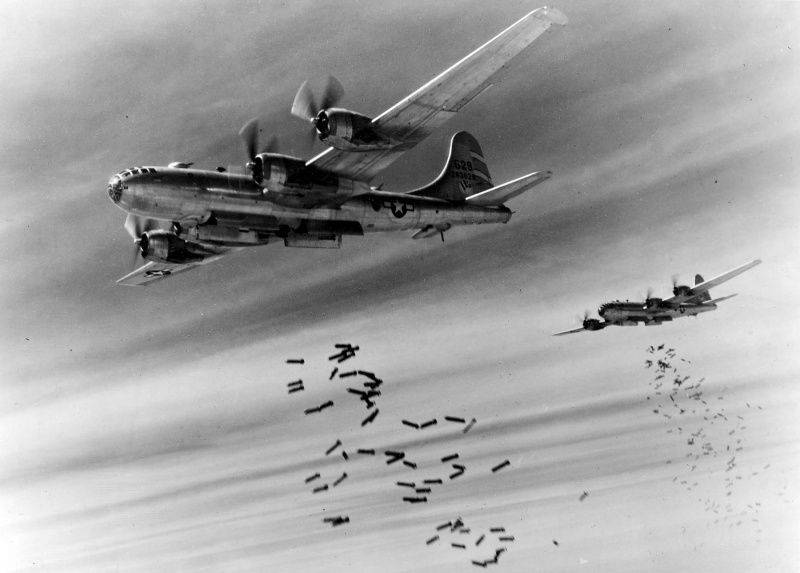
American bombers B-29 bombing the Burmese city of Rangoon
Allied offensive. Capture of manila
In accordance with the strategic plan adopted, the attack of the US-British forces in 1945 began with the capture of Luzon Island. The troops of the 14 of the Japanese Army under the command of General Yamashit held up their defenses here. The total number of Japanese troops, including the garrisons of security troops and auxiliary units, reached 180 thousand people. The main Japanese grouping (about 90 thousand soldiers) was located in the northern part of the island, where the Japanese were waiting for the landing of enemy forces. Thousands of 20-30 groups of thousands of people were concentrated on the southwestern coast of Luzon, in the southern part of the island and in the Manila region. From the air, the Japanese army supported the 200 aircraft. There was almost no support from the sea, except for individual patrol boats and boats.
The lack of support from the sea and weak air cover made the Japanese defense vulnerable. In addition, the Japanese command was unable to correctly determine the time and place of the next strike of the enemy. Therefore, the main forces of the 14 Army were concentrated in the interior of the island, so that, if necessary, they could be quickly transferred to the western or eastern coast, to the place where the Americans landed. Directly on the coast were small Japanese garrisons from the company to the battalion. The antiamphibious defense, even in the most dangerous areas, was weak. In addition, large groups of Filipino partisans operated in the Japanese rear. Thus, the national liberation army of Hukbalahap numbered about 70 thousand fighters. Only this connection of the Filipino partisans destroyed about 25 thousand Japanese soldiers. The guerrillas liberated about 1 million peasants in the northern part of the island and occupied a number of important points of Luzon even before the landing of the American troops.
The island was liberated by the 6th American Army under the command of General Kruger. The American army included two army corps (two divisions in each), separate infantry and airborne divisions, a special infantry regiment, tank group and a number of other special and auxiliary units and divisions. In the combat units of the army (not counting the division of the airborne troops) there were more than 152 thousand people, in the service troops - more than 50 thousand people. After the seizure of the bridgehead, the army was planned to be strengthened by four more divisions and a regiment. To ensure the operation from the air, about 1300 aircraft, which were based on aircraft carriers, and about 800 aircraft of three air armies, were involved in the operation. Landing was carried out by the main forces of the 7th and 3rd American fleets, which included about 850 different ships. Thus, the Americans had complete superiority at sea and in the air, and created an advantage in the ground forces.
In the preparatory period, the Americans created large bases and stocks of material resources in the Philippine Islands, captured in the 1944 year. The US Air Force struck powerful blows at Japanese airfields, troop assemblies and communications hubs on the islands of Luzon, Taiwan and Ryukyu.
The operation began on 9 on January 1945 of the year. Two army corps landed under the cover of powerful strikes of the fleet and aircraft. The resistance of the Japanese troops, who did not expect an enemy to appear in the Lingen area, was weak and unorganized. Separate Japanese garrisons under heavy pressure began to retreat deep into the island. The transfer of Japanese forces from the depths of the island began with a delay and was greatly hampered by the strikes of American aircraft and the actions of the partisans. As a result, the landing of the American landing took place in ideal conditions. The Americans were able to land almost without meeting the resistance of the enemy and could calmly continue the fight against the disorganized and demoralized Japanese troops.
The Americans on the very first day landed 68 thousands of soldiers and officers and occupied a bridgehead with a length of 24 km and 5 km in depth. This allowed the deployment of forces to capture the entire island. 10 January 1945. American troops launched an offensive, with strong support from artillery and aircraft. The main forces of the American army were advancing in the general direction of Lingen - Manila. Not encountering strong resistance, the American troops broke through a narrow wedge along the railroad and highway.
In two weeks, the Americans advanced on 100 km. In the afternoon of January 28, the advance units of the American troops were in 80 km from Manila. However, here the Japanese resistance has increased dramatically. Repeated attempts of the American troops to break through the defenses of the enemy were unsuccessful. In addition, there was the threat of flank attack by Japanese troops. Then the allied command, in order to defeat the Japanese in the southwestern part of Luzon and secure the right wing of the 6 Army attack group, on January 29 landed one 8 US Army corps in the rear of the Japanese army north of Olongano. Manila was supposed to take the 14-th Army Corps, which had in its composition tank and motorized units. To support him, 31 landed an airborne division south of Manila.
February 1 Americans resumed an offensive on Manila from the north and south. Japanese resistance turned out to be surprisingly weak, and the 14 corps in three days passed 70-75 km and reached the northern edge of the capital of the Philippines. Soon the paratroopers advancing from the south came to Manila. 20-thousand the Japanese garrison of Manila was surrounded. However, surrounded by the Japanese had extremely fierce resistance, continuing to fight under the most unfavorable conditions. Only a large numerical advantage and technical superiority allowed the Americans to take up. After persistent battles for February 22, the main part of Manila passed into the hands of American troops. Only in the quarters of the Old City, enclosed by a fortified wall, and in several stone buildings, the Japanese continued to stubbornly fight back. To suppress the last pockets of resistance of the enemy, the Americans had to attract aviation, heavy artillery, tanks and self-propelled guns. February 23 after hours of artillery preparation and air strikes Americans were able to break through the gaps and break into the Old City. For two days, fierce battles were fought in the basements, communications, and casemates of the old fortress. By the end of February 25, all defenders of the Old City were killed. In early March, 1945, the Americans suppressed the last pockets of resistance and completely took the capital of the Philippines.
During the battles for Manila, the Americans 16 February after heavy air strikes and long shelling of ship artillery landed naval and airborne troops on Correhidor Island, which controlled the entrance to Manila Bay. 6-thousand the island’s garrison, which suffered heavy losses from shelling and air strikes, stubbornly resisted. The Japanese soldiers, blindly believing in the fair nature of the war, fought with extreme persistence. Being in a bind, they blew up underground communications with themselves. By February 28 Japanese resistance was crushed. The entrance to Manila Bay was open. The American command was given the opportunity to create a base in Manila.
Subsequently, the Americans continued to fight to destroy isolated from each other Japanese groups in the southern and northern parts of Luzon. The southern group was destroyed by the end of April 1945. However, the fighting continued until July 1945. And in the north of the island, separate units of the Japanese army resisted until the end of the war.
The final loss of the Philippines significantly worsened the strategic position of Japan. Her sea communications with the South Sea zone were interrupted. The Japanese could no longer export strategic raw materials (primarily oil and oil products) by sea from Indonesia. Now resources from Indonesia could only be transported via Indochina and China. The Americans established control over the South China Sea. There was a direct threat to Japanese troops stationed in Indonesia, Indochina, on the east coast of China and on the islands of Hainan, Taiwan, Ryukyu.
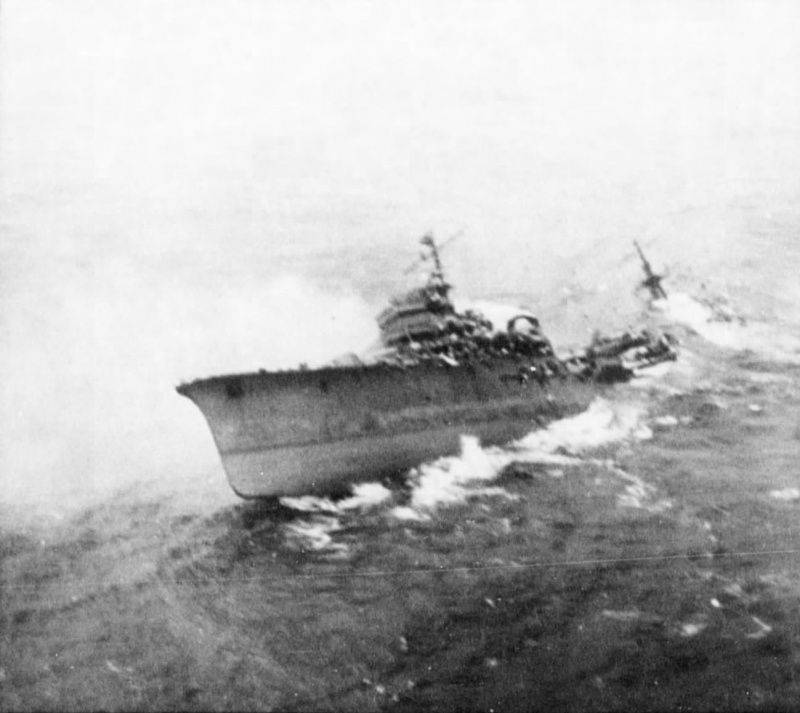
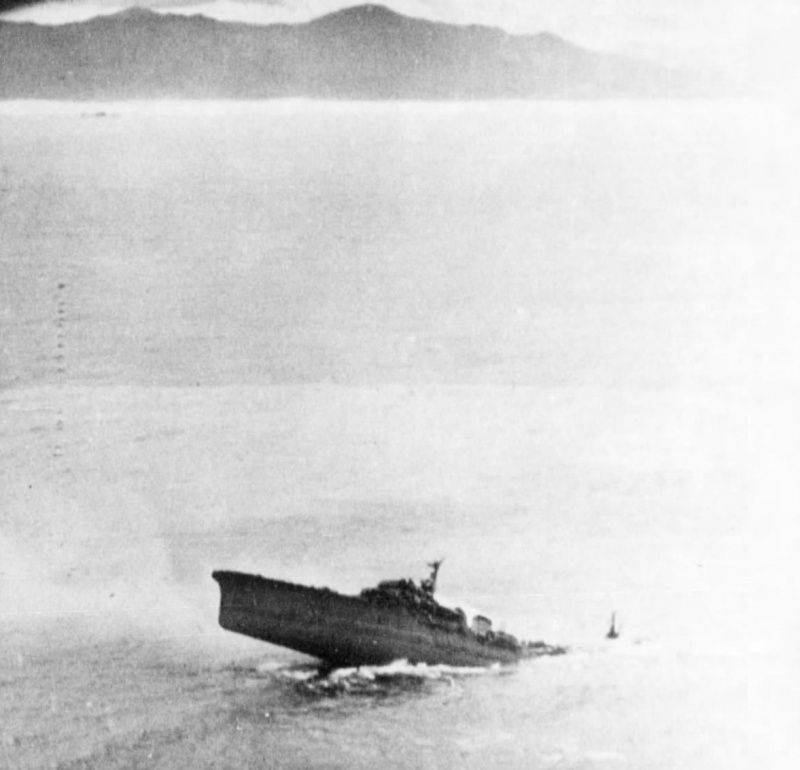
The death of the Japanese light cruiser "Casia" off the coast of French Indochina. 12 January 1945 of the "Casia" as part of the HI-86 convoy was subjected to massive attacks of deck aircraft from the aircraft carriers of the 38 American operational connection. As a result of hitting a torpedo and two bombs, he went to the bottom, taking with him a 621 Japanese soldier. Only 19 of Japanese sailors managed to survive. The fate of the "Kasia" and shared most of the ships of the Japanese convoy HI-86. Photo source: http://waralbum.ru
Allied victory on the Burmese front
The situation of Japanese troops in Burma has worsened. Here, the US-British and Chinese troops, with the support of the Burmese partisans and the local population, continued the offensive. As in the Philippines, the Allies had an overwhelming advantage in technology as well as in troop strength.
K 22 January 1945 the allies occupied the Burmese-Chinese highway. The road to China by land was open. The 14-I British Army, which was advancing in Central Burma, broke the resistance of the Japanese troops on the Irrawaddy River, March took Mandalay and marched south along the railway leading to Rangoon. Meanwhile, in the south-west of Burma, British amphibious assault forces captured the islands of Ramri and Chedub, while the 21 Indian Corps, after capturing Akyab, advanced along the coast, preparing to seize the Burmese capital, Rangoon. At the same time in the Japanese rear raised an uprising of the so-called. 15-thousand "Burmese army", formed by the Japanese from the locals. The Burmese troops struck the rear of the retreating Japanese units. 50-I and 15-I Japanese armies were forced to accelerate the withdrawal in the direction of Thailand.
On May 2, English troops entered Rangoon, abandoned by the Japanese. Most of Burma was liberated from Japanese troops. The US-Chinese forces operating in the north of Burma were sent to China. In Burma, in addition to the 14 of the English army that was stationed there, the 12 of the English army was formed. During the period of May – August 1945, these British forces completed the rout of the Japanese forces in Burma and cleared the eastern part of the country from them.
The defeat of the Japanese army on the Burmese front was of considerable strategic importance. The Japanese strategic defense in other countries of Southeast Asia was greatly weakened. There was a real threat to the Japanese forces stationed in Thailand, Malaya, Indochina and Indonesia. The naval base in Singapore lost its former operational significance.
At the same time, the US-British forces eliminated the threat from the Burmese springboard against India. A land connection with China was created. The main grouping of Japanese troops in Southeast Asia was defeated. The US-British command created favorable conditions for conducting operations to liberate Malaya and Singapore, occupying the most important points of Thailand and the islands of Indonesia.
The directive of the Joint Chiefs of Staff Committee on 2 August 1945 ordered the commander of the armed forces in Southeast Asia to continue the offensive in order to liberate Malaya, restore the naval base in Singapore, establish bases on the islands of Java and Sumatra, and hinder the enemy forces in Thailand. Part of the troops had to begin training for action in the Japanese metropolis. However, the planned operations were not carried out until the end of the Second World War. Only the Anglo-Australian troops captured the Indonesian islands of Java, Borneo and Celebes.
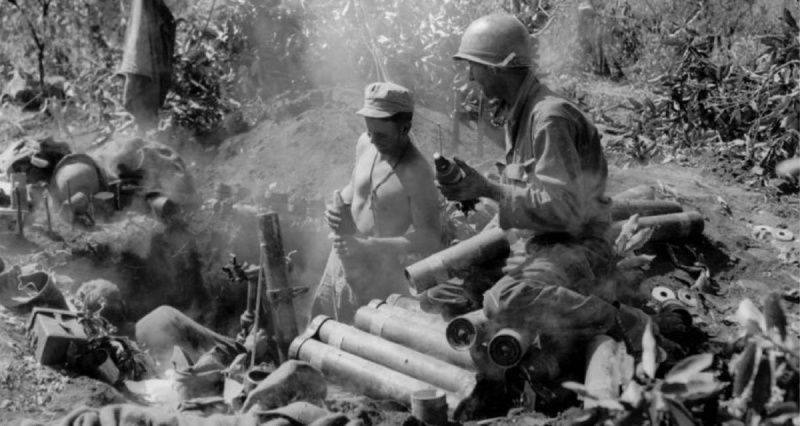
American soldiers fire on Japanese troops in Burma from 81-mm mortar М1
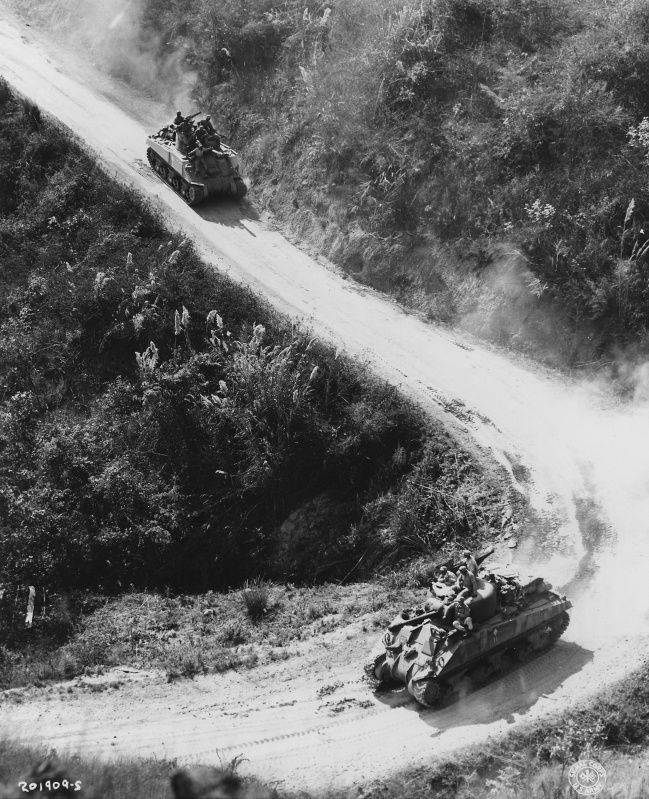
Tanks МХNUMX "Sherman" with Chinese crews on the China-Burma-India road cleared of Japanese troops
To be continued ...
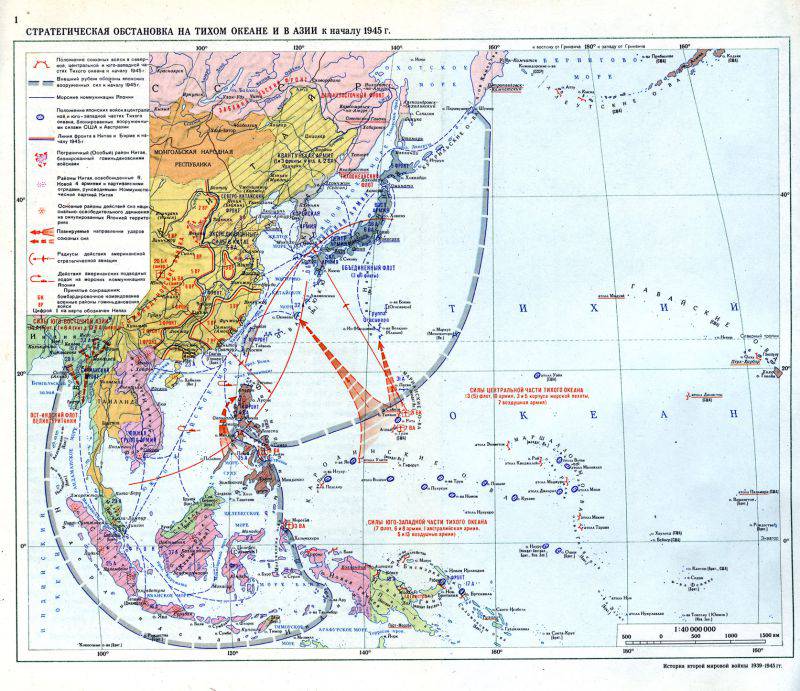
Information